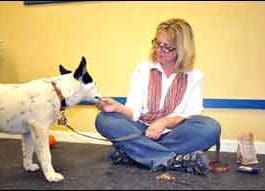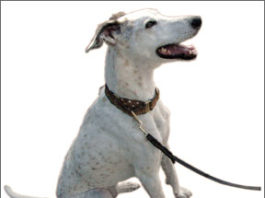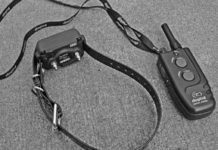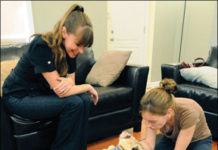The Canine Shock Collar Debate
The chasm between those who abhor the electronic/shock collars as an abusive dog training tool and those who support and promote it as an exceptionally effective and humane training tool is so huge it will probably never be bridged. In more moderate positions in the middle of that chasm are those who believe that the collar can be an effective training tool for very limited circumstances in the hands of skilled professionals, and those who prefer not to use them but feel compelled to educate clients who insist on using them on how to use them properly.
Tethering Your Dog for Training
For many years, I have been a vigorous and vocal opponent of keeping dogs tied or chained as a primary means of confinement. The hazards of tying a dog are well-documented, and include increased aggression, vulerability to human and non-human intruders, and the risk of hanging or choking. It may come as a surprise, therefore, to know that I regard the tether as an invaluable piece of training equipment. The difference and it's a big one is in the application.
Train Your Dog to Accept Hugs
The process of teaching a dog to tolerate hugging involves either classical conditioning (giving a puppy a positive association with something she doesn't already have an opinion of), or classical counter-conditioning (giving a dog a new association with something she already has a negative opinion of). Either way, the process is similar, but it may go slower if you are working to change an existing opinion rather than simply installing one where none previously exists.
Promoting Positive Training Methods
Every so often, at a training demonstration or event promoting positive training methods, a skeptical spectator will ask me whether positive training methods can be used for preparing dogs for all types of careers. I know where they are usually going with this question. Their real question is, “I know you can teach dogs to do cute little tricks with treats and stuff, but what about when you want a reliable dog, like an obedience competitor, a protection dog, or a police dog?” Their assumption is that in order to teach a dog to respond without fail, to sharply execute the handler’s every command, you will have to use force- and fear-based methods at some point in the dog’s education.
An Extreme Inappropriate Response
Many years ago, when I was a Customer Care Supervisor at the Marin Humane Society, in Novato, California, we received a frantic phone call from a woman who had glanced over her fence and noticed her neighbor’s adolescent Dalmatian tangled up in her tie-out rope so badly that she couldn’t move. Rushing to the address, the Society’s humane officer did, indeed, find the tangled dog, but there was something suspicious about the scene. The rope was coiled and knotted so neatly around the dog’s legs that it left no room for doubt in the officer’s mind.
Install an Off-Switch on Playtime
you are in for a lot more of the same."
Counter-Conditioning and Desensitization (CC&D)
Counter conditioning and desensitization (CC&D) involves changing your pup's association with a scary stimulus from negative to positive. The easiest way to give most pups a positive association is with very high-value, really yummy treats. I like to use chicken canned, baked or boiled.
Counter-Conditioning and Desensitization for Reducing Dog Reactvity
Counter-conditioning involves changing your dog’s association with a scary or arousing stimulus from negative to positive. Desensitization is starting with a very low-level intensity of aversive stimulus until the dog habituates to (or changes his association with) the aversive, and then gradually increasing the strength until the dog is comfortable with the stimulus at full intensity. The easiest way to give most dogs a positive association and to help them become comfortable with a stimulus is with very high-value, really yummy treats. I like to use chicken – canned, baked, or boiled; most dogs love chicken. Here’s how the CC&D process works.
Teach Your Dog to Make Eye Contact
If your dog doesn't already know the value of eye contact with humans, you can easily teach her. This is an operant conditioning/positive reinforcement exercise your dog learns her behavior can make good stuff happen. When your dog has come to realize the value of eye contact, she will sometimes offer the behavior without being cued. Be sure to reinforce offered eye contact as well as cued eye contact. To help her be comfortable with eye contact from other humans, ask your friends to play the Watch" game with her as well."
The Four Principles of Operant Conditioning for Dogs
The dog's behavior makes something good happen. Positive
Understanding Reward Based Dog Training
In the 1950s, behavioral scientist B.F. Skinner developed a number of principles that are applicable to all living things with a central nervous system. He found that animals are likely to repeat behaviors that are enjoyable/rewarding to them, and not likely to repeat behaviors that result in something unpleasant (punishment). Neutral stimuli – things that don’t matter to the animal – don’t have an impact on behavior one way or the other. Skinner demonstrated that humans can use these simple principles to modify an animal’s behavior. Rewards are the most reliable way to deliberately increase an animal’s offered behaviors; conversely, punishment decreases those behaviors. (See “The Four Principles of Operant Conditioning,” next at end of story). We use these behavioral principles in dog training with great success.
Victoria Stilwell Promotes Positive Dog Training on Television
and then it means leash jerk! The dog's not learning to walk close to me because he wants to, he's learning to walk close to me because he fears what's going to happen to him if he doesn't. I have to say this was a long, long, time ago. I thought, This is bizarre

















